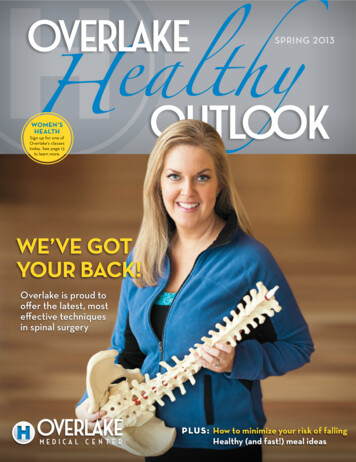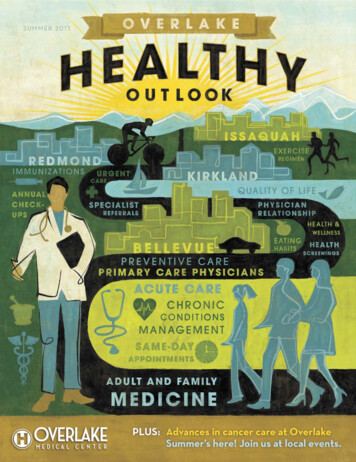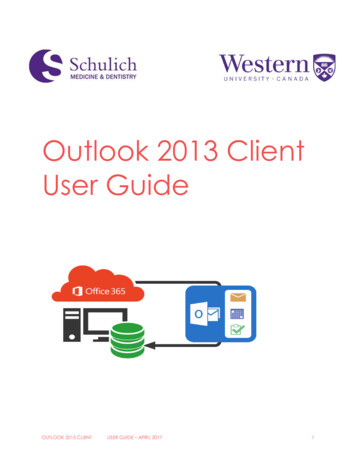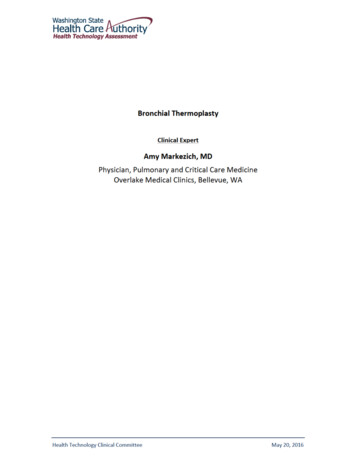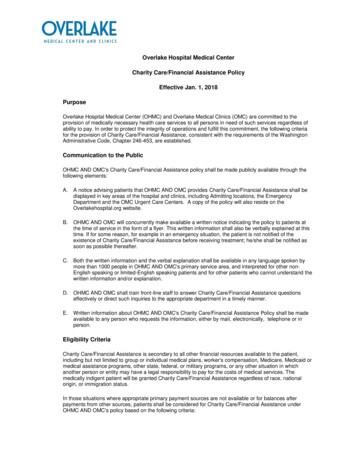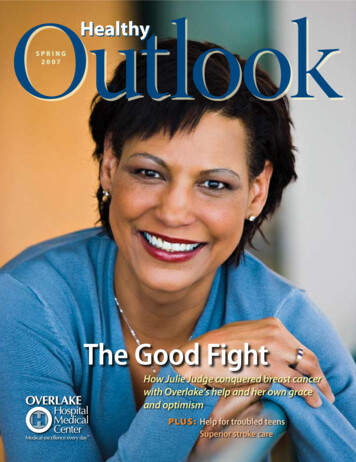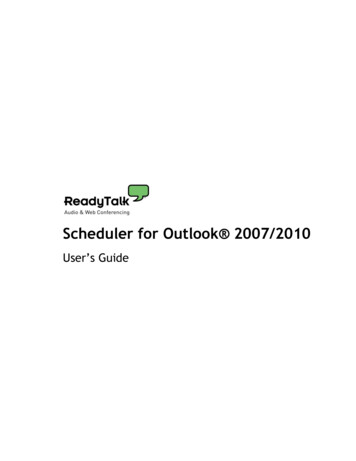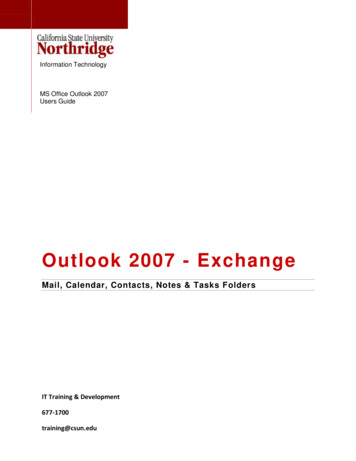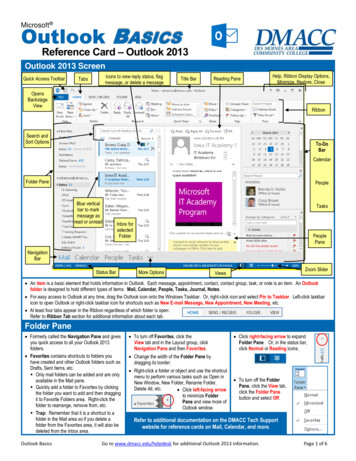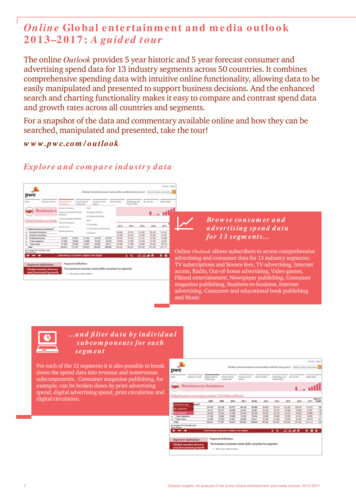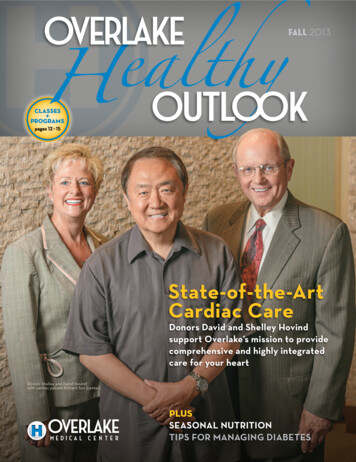
Transcription
ealthyHOVERLAKEClasses ProgramsFALL 2013OUTLOOKState-of-the-ArtCardiac CareDonors David and Shelley Hovindsupport Overlake’s mission to providecomprehensive and highly integratedcare for your heartDonors Shelley and David Hovindwith cardiac patient Richard Sun (center)PLUSSEASONAL NUTRITIONTIPS FOR MANAGING DIABETES
From the President & CEOWe think the best way to care for our neighbors is to bein the neighborhood. That is why we continue to enhanceour healthcare services in local neighborhoods across theEastside—most recently in Issaquah.This fall at our Overlake Center location on East LakeSammamish Parkway SE, we will open an expanded urgentcare clinic, while we work on merging Overlake MedicalClinics Issaquah and Gilman, our two primary carepractices, by the spring of 2014. In addition, we have addedthe newest technology in outpatient medical imaging justnext door. It’s easy access to primary care, urgent care andmedical imaging in one, convenient location.For your specialty care needs, we offer a wide range ofservices just down the street in Issaquah at our HighmarkSpecialty Clinic on NW Maple Street. There you can makeappointments with our Cardiology, Pulmonary, BreastScreening and Anticoagulation clinics. All of our clinicsare connected to the hospital, offering you a full spectrumof medical services.Thank you for letting Overlake care for you andyour family.Sincerely,Craig HendricksonPresident & CEOH ealthy Outlook FALL 2013Board of T rust ee sCecily HallRichard Clarfeld, MDBertrand ValdmanCraig HendricksonJim DoudRobert CampbellPatricia BedientGregory CollinsJanine FlorenceKemper Freeman, Jr.John B. HayhurstBoard ChairImmediate Past ChairSecretaryTreasurerTom Miller, MDChief of StaffChief of Staff ElectPresident & CEOAssistant Secretary2 Healthy OutlookDavid HovindLinda MahaffeyDoug MartinLani MobiusNolan NewmanRussell StockdaleThomas Stoll, MDOverl ake M edical Center1035 116th Ave. NE425-688-5000 Bellevue, WA 98004www.overlakehospital.orgOverlake Hospital Medical Center is a nonprofit, independently operated regional medical centeroffering, in association with medical staff, a wide range of health technologies and specialtyservices. Earnings are devoted exclusively to the continuation and improvement of patient servicesand facilities, as well as educational, outreach and research activities. The information in thispublication is not intended for the purpose of diagnosing or prescribing. If you have concernsabout health issues, contact your personal physician.Periodically, we send communications to friends and neighbors in our community that describe thehealthcare services and products we offer. If you would prefer not to receive communications likethis from our organization, please call 425-467-3548 or e-mail healthyoutlook@overlakehospital.org.Healthy Outlook 2013. Published by the Overlake Marketing Department.Director of Marketing and Public Relations: Kipepeo Brown.Executive Editor: Kelly Blake.Art Director & Photography by Garland Cary.Photography by Brian DalBalcon.For an e-copy, visit www.overlakehospital.org/healthyoutlook.
N ews You C an UseMOTIONis LIFEIs joint pain keeping you from enjoyinglife? Join us for our complimentaryseminar to learn more about joint painrelief and an in-depth discussion on hipand knee replacement.Wed., Oct. 16, 6:30–8 p.m.at Overlake Medical Clinics HighmarkSpecialty Clinic with Steven Ratcliffe, MDFind Breast CancerEarlyWed., Oct. 23, 6:30–8 p.m.at Overlake Medical Center withJonah Hulst, MDBeginning in their 20s, women should be aware of how theirbreasts normally look and feel and report any new breastchanges to a health professional as soon as they are found.Age 20–39:Age 40 and over: C linical breast exam by ahealthcare professional everythree years. Yearly mammogram. Yearly clinical breast exam.Wed., Nov. 6, 6:30–8 p.m.at Overlake Medical Center withJames Bruckner, MDWomen at high risk should talk with a doctor about starting mammogramsat a younger age and using breast MRI to screen for breast cancer along withmammograms and clinical breast exams.Call 425-688-5985 to schedule an appointment or visitwww.overlakehospital.org/breasthealth for more information.For more information, call 425-688-5259or visit www.overlakehospital.org/MIL.Preregistration required.FALL 20133
The Doc tor RecommendsFit to PlayPreventing injury is a winning strategy for active boys and men—no matter your age.Want to stay ahead of the game when it comes to sports injuries? Checkout the following advice from two experts at Overlake Medical Center:Gary Chimes, MD, PhD, who specializes in physical medicine andrehabilitation, and rehabilitation manager Garrett Knappe, PT, DPT.What are common sports injuriesamong young boys and teens and tipsfor prevention?Dr. Chimes: Kids tend to get more traumatic injurieslike fractures and sprains, partly because their bones areweaker and they play more contact sports. They’re alsomore prone to overuse injuries than adults. That’s whyit’s good when kids play multiple sports and don’t startspecializing too early. Also, children are significantly morevulnerable to concussions than adults. Parents shouldknow risks of secondary concussions, which happen whenyou suffer another concussion before you’ve recoveredfrom the first. To avoid an even more serious reinjury, restand “therapeutic boredom”—minimizing stimulation—isessential after a concussion.Gary Chimes, MDGarrett Knappe, PTGarrett Knappe: For prevention’s sake, kids—and athletesof all ages—should use proper equipment that fits well.Also, kids should be supervised by qualified adults and beprepared to play—with proper training and warm-ups andcool-downs. In my experience as a soccer coach, not enoughattention is given to proper stretching. It can add range ofmotion, make kids more limber and help prevent strainsand sprains.What gets weekend warriors in theworst trouble?Garrett Knappe: By far, it’s not knowing their limits.Basketball, for example, is one of the highest-impact sports.If you decide to play it or other sports, train for it and allowyour body to adapt to the new activity, using the righttechniques. An even better idea: Engage in regular exercisethroughout the week.How should men develop a safe andhealthy exercise program as they getolder?Dr. Chimes: Seniors often have chronic conditions suchas diabetes or heart problems. I’d advise them to consult aphysician with expertise in sports medicine and make suretheir exercise program matches their needs. Being assessedfor osteoporosis and knowing whether you’re at risk offractures can also be helpful. People think of osteoporosisas a woman’s disease, but men get it too.4 Healthy Outlook
NutritionSimple Whole-Wheat BreadAutumnNutritionTemperatures are starting to cool down and leavesare turning from green to shades of red, yellow andorange. The change in colors is a reminder to keepa variety of colors in your daily diet. Fruits andvegetables provide essential vitamins and minerals,fiber, and other substances important for goodhealth. Most fruits and vegetables are naturally lowin fat and calories. Additionally, they are high infiber, which is filling.Antioxidants are found in a range of foods, butparticularly in colorful fruits and vegetables. Fruit: Apples, bananas, grapes, nectarines,peaches, pears, plums, tomatoes, watermelon andnashi pears. Vegetables: Asparagus, beans, broccoli,carrots, cucumbers, eggplant, lettuce, mushrooms,potatoes, pumpkins, snow peas, spring onions,sweet corn, turnips and zucchini.NutritionServicesYou can learn how to help yourself leada healthier life through the food choicesyou make. For more information, callNutrition Services at 425-688-5484or visit dients:3 cups warm water2 packages active dry yeast2/3 cup honey5 cups bread flour5 tablespoons butter, melted1 tablespoon salt3½ cups whole-wheat flourDirections: In a large bowl, mix warm water, yeast and ⅓ cup honey. Add5 cups white bread flour, and stir to combine. Let set for 30 minutes,or until big and bubbly. Mix in 3 tablespoons melted butter, ⅓ cup honey and salt. Stir in 2cups whole-wheat flour. Flour a flat surface and knead with wholewheat flour until just barely sticky—just pulling away from thecounter but still sticky to touch. This may take an additional 2 to 4cups of whole-wheat flour. Place in a greased bowl, turning once tocoat the surface of the dough. Cover with a dish towel. Let rise in awarm place until doubled. Punch down, and divide into three loaves. Place in greased 9-by-5-inchloaf pans, and allow to rise until dough has topped the pans by 1 inch. Bake at 350 F for 25 to 30 minutes; do not overbake. Lightly brushthe tops of loaves with 2 tablespoons melted butter or margarinewhen done to prevent crust from getting hard. Let cool.Pineapple Apricot SauceThis sauce is an easy alternative to pre-made jams or frostings.It contains no sugar or fat.Ingredients:1 cup apple juice concentrate1½ teaspoons agar powder1 cup water1 cup chopped apricots, fresh,frozen or canned1 8-ounce can juice-packedcrushed pineapple¼ teaspoon ground gingerDirections: Combine apple juice concentrate, agar and water in a saucepan. Letstand 5 minutes. Bring to a simmer, stirring occasionally and cook3 minutes. Add apricots, pineapple with its juice and ginger. Stir to mix.Remove from heat and chill thoroughly, 3 to 4 hours.FALL 20135
TakeBrand-newfacilities andstate-of-the-artproceduresboost Overlake’ste-3.1L.t cartcardiac6 Healthy Outlook
HeartWith the state-of-the-art David and ShelleyHovind Heart & Vascular Center nowopen, Overlake Medical Center’s cardiacservices can be accessed in one convenientlocation. “The new Heart & VascularCenter brings all our people and services ininterventional cardiology together, includingelectrophysiology, cardiac catheterization,interventional radiology and a 15-bed patientcare unit,” says Joseph Doucette, MD, medicaldirector of invasive cardiology at Overlake.“This will improve the patient experience byincreasing access to specialized care whileminimizing travel throughout the hospital. Thecenter also allows physicians across differentsubspecialties to collaborate more efficiently.”The new facilities, along with the introductionof minimally invasive heart procedures,demonstrate Overlake’s ongoing commitmentto comprehensive cardiac care. The new centerFALL 20137
was made possible through generous communitydonations.Cardiac Arrhythmia: Leading-Edge EvaluationThat careful design includes two new electrophysiology(EP) labs that cardiologists Jeffrey V. Fowler, MD; J. AlanHeywood, MD; and Derek M. Rodrigues, MD, FACC useto evaluate and treat patients with arrhythmia, a conditioncharacterized by an irregular, fast or slow heartbeat.Arrhythmias occur when the electrical signals that controlthe heart’s rhythm become disrupted. An aging populationis driving up the number of patients with atrial fibrillation,a rapid heart rhythm that can increase risk for stroke andheart failure. “What’s exciting about electrophysiology isthat often we can offer a cure for a patient’s conditioninstead of just managing the disease,” Dr. Rodrigues says.The spacious EP labs will enable Overlake to treat moreatrial fibrillation patients using a minimally invasivetechnique called catheter ablation. This procedureinvolves guiding thin, insulated wires—typically throughveins in a patient’s leg—to target the heart tissue in whichthe displaced electrical signal is occurring. Multipleimaging technologies—including a sophisticated mappingsystem that produces a 3-D reconstruction of theheart—help cardiologists determine where to deliverradiofrequency energy or freezing therapy to block thearrhythmia’s electrical pathway. “Patients don’t have anystitches or wounds,” Dr. Heywood says. “Recovery isseveral hours of bed rest. People are usually back on theirfeet within six hours of the procedure.”8 Healthy OutlookAnother type of arrhythmia therapy involves implantingdevices that monitor and regulate the heartbeat withelectrical pulses or jolts. “A defibrillator is meant toprevent cardiac arrest, whereas a pacemaker is designedto regulate the heartbeat,” Dr. Fowler says. Additionaltreatment options include cardiac resynchronizationtherapy, medications and surgery. Patients also visit theEP labs for evaluation and diagnosis. “Patients may beanxious about having arrhythmias occur even if they’renot life threatening,” Dr. Rodrigues says. “Our role is tomake patients knowledgeable about their condition andguide them with a management plan that works for them.”Transcatheter Aortic Valve Replacement(TAVR) for Aortic Valve DiseaseAnother minimally invasive, catheter-based procedure iscoming this fall to the operating room, making Overlakejust the fourth center in the state to offer transcatheteraortic valve implantation/replacement (known as TAVIand TAVR), a treatment for aortic stenosis patients whoare inoperable or at high risk for surgery. Aortic stenosisis the narrowing of the aortic valve—usually caused bycalcium buildup or scarring—that restricts blood flowthrough the heart, sometimes resulting in heart failure.“This program requires highly qualified physiciansfrom multiple disciplines working in teams,” sayscardiologist Ronnier Aviles, MD, who compares theemergence of TAVI to the introduction of stents inthe 1990s. “We’re at the juncture where technology ischanging the field of cardiology yet again.” TAVI, whichwas approved by the FDA in 2011, involves introducing
a catheter into the groin, chest, right armor tip of the heart to implant a bovinetissue valve with a stainless steel meshframe. “The transcatheter valve is basicallya large stent with a compressed tissueheart valve on a balloon catheter,” saysJames Leggett, MD, a cardiologist. “Oncewe put the catheter across the valve, weexpand the balloon to compress the oldvalve out of the way. Then we remove theequipment, leaving the new valve in place.”A clinical trial is underway to study TAVI inlower-risk patients; thus far, the FDA hasapproved the procedure only for high-riskand inoperable patients.“Previous to this technology, patients[diagnosed with severe symptomatic aorticstenosis] who were not surgical candidatescarried a mortality rate as high as 50percent at two years,” says Scott Haugen,MD, a cardiologist at Group Health, whichis partnering with Overlake on the newprogram. In a clinical trial, TAVI reducedmortality in the same patient populationby 20 percent. “This is an opportunityfor Overlake and Group Health to notonly help improve those patients’ lengthof life, but also their quality of life,” saysDr. Haugen. Before TAVI, some patientshad no choice but to live with symptomsincluding shortness of breath, chestpain and fainting. “Our goal is to have atruly comprehensive program that offerspatients the best available care and mostappropriate therapy for each patient,”Dr. Aviles says.To learn more, visitwww.overlakehospital.org/cardiac.A Gentler Approach“The David and Shelley Hovind Heart & Vascular Center consolidates all theexisting cardiac service line functions at Overlake, including electrophysiology,cardiac catheterization, interventional radiology and a 15-bed patient care unit.”Minimally invasive valve surgery gotMark Phelps back to work—and life—faster than traditional surgery.A broken breastbone, an unsightly scar in the center of the chest and along road to recovery were once unavoidable impacts of heart surgery.Not anymore—at least for some patients—thanks to minimally invasiveheart surgery now available at Overlake Medical Center.Sammamish businessman Mark Phelps was one of the first patients atOverlake to have the procedure. Phelps had a leaky mitral valve, whichwas causing his heart to work overtime, pumping 50 percent moreblood than normal. Due to the severity of Phelps’ leak, his cardiothoracicsurgeon, Robert Binford, MD recommended an annuloplasty, whichinvolves inserting a ring around the base of the heart valve to narrow itsopening. Within 10 days after the procedure, Phelps returned to his officewith just one small scar on the side of his chest, where Dr. Binford hadaccessed the heart with 10-inchinstruments, and a second small scaron his groin, where the heart-lungon the covermachine had been attached.“With traditional heart surgery, mostpeople can’t get back to a full-time jobuntil about six to eight weeks minimumpost-surgery,” says Dr. Binford, whohelped establish Overlake’s minimallyinvasive heart surgery program last fall.“Faster recovery is a huge advantagebecause a lot of people can’t stay outof work that long without significantfinancial hardship.”Overlake offers several minimallyinvasive heart surgeries, including mitralvalve repair and replacement, aorticvalve replacement, tricuspid valverepair, septal defect repair and the mazeprocedure for atrial fibrillation. “Thefact that we’ve been able to build thisprogram so successfully is a teamsuccess,” Dr. Binford says.Richard Sun, featured on the coverbetween Shelley and David Hovind, wasone of the Heart & Vascular Center’sfirst patients. He was treated by JosephDoucette, MD. “Before my procedure,I felt tightness in my chest,” Sun says.“Now, it’s all gone. Dr. Doucette saved mylife.” Sun underwent a complicated stentprocedure in July but returned home afterjust one night in the hospital. He says he’sthankful for a facility that allowed himaccess to such greatcardiaccare. 9FALL2013
Foundation & AuxiliariesCommunity PartnersEvent Goes GlobalAs part of Overlake’s commitmentto the health and wellnessof the Eastside, theFoundation will providea forum for businessand community leadersPhyllis Campbellto come together for(above) and Kempera thought-provokingFreeman (right) will discussdiscussion at our Communitythe role of healthcarein shaping a globallyPartners Luncheon. The luncheon willcompetitive region.feature a stimulating conversation withtwo prominent and respected business leadersin the Puget Sound community: Phyllis Campbell, chairman, PacificNorthwest Region, JPMorgan Chase & Co., and Kemper Freeman Jr.,chairman and CEO, Kemper Development Company.Moderated by Puget Sound Business Journal columnist PattiPayne, “World-Class Planning and Caring for Our World-ClassRegion” promises to be a lively exploration of the relationship betweenexceptional healthcare delivery to meet the needs of our growingcommunity and the Eastside’s ability to beincreasingly competitive in the globalMon., Nov. 25,markets of the future.noon–1:30 p.m., at theHyatt Regency Bellevue.Proceeds from theTickets are 150 each.Community Partners LuncheonFor more information,will go to Overlake’s Ensuringvisit www.overlakeExcellence Fund.hospital.org/cpl.Heart & Vascular CenterNow Open!We would like to thank our generous donorsfor helping to make this state-of-the-art facilitypossible. The Foundation & Auxiliaries raised 4 million to bring our outpatient diagnosticand treatment services together for a bettercare experience for our patients and families.Contributions from our community help Overlakeprovide world-class care by bringing advancedservices to the Eastside.The Foundation & Auxiliaries continueto raise funds for the addition of a VascularInterventional Radiology suite with biplaneimaging technology, as well as supportingthe development of Cardiac Arrhythmia andNeurointerventional Centers of Excellence.From left: Patty Edwards; David and ShelleyHovind; and Patricia Zundel, MD, celebratethe opening of the David and Shelley HovindHeart & Vascular Center.Learn More About Giving and Volunteeringwww.overlakehospital.org/supporte: foundation@overlakehospital.orge: auxiliaries@overlakehospital.org10 Healthy OutlookXxxOverlake Medical CenterFoundation & AuxiliariesXxx 116th Ave. NE1035Bellevue, WA 98004Foundation: 425-688-5525Auxiliaries: 425-688-5527
S enior S er vicesManagingDiabetesTake control of your health with a fewlifestyle changes.The risk for developing Type 2 diabetes increases aspeople age, but managing diabetes does not have tobe difficult. Healthy living principles are the samefor diabetics as everyone else. Make healthy food choices, bephysically active and take medications as prescribed by yourphysician.Create Your Plate!An easy way tomanage intake is to use the“plate method” to select portion sizesand ensure that you do not eat morecarbohydrates than you need. Take a 10-inchplate and imagine it divided into sections. Fill onefourth of the plate with a starch (whole grain breads,crackers, pasta), one-fourth with protein (fish,chicken, lean beef/pork) and the other half withnonstarchy vegetables such as broccoli,green beans, asparagus or carrots. Adda glass of milk on the side.An important component of managing diabetes ismaintaining your blood sugar levels within the recommendedgoals set by the American Diabetes Association. Blood sugarlevel goals are: Less than 130 before eating. Less than 180 one to two hours after eating.Blood sugar is affected by diet, exercise and blood glucoselowering medication. An excellent way to help manage bloodsugar levels is to engage in regular physical activity. Youshould warm up, stretch and cool down to prevent injuries. Ifyou are not active right now, you should start slowly.To maintain a healthy diet and to control blood sugars,it is most important to pay attention to your intake of allcarbohydrates. Carbohydrates are made up of: Starches. Sugars, both natural and artificial.A high-fiber diet can also help with better blood sugarcontrol and even help prevent heart disease and diabetesand promote weight loss. So how much fiber do we need?The American Dietetic Association says we should consumebetween 20 and 35 grams of fiber daily.To get a more personalized meal plan, consider seeing aregistered dietitian. Getting individual attention and advicecan make a big difference in your management of diabetes.Talk to your primary care physician to receive a referral tomeet one-on-one with a registered dietitian.FALL 201311
Classes and ProgramsClasses are offered at multiple locations. Check your confirmationletter for more details. Preregistration required.Two easy options for registration:1. Go to www.overlakehospital.org/classes.2. Call 425-688-5259, Monday–Friday, 8 a.m.–4:30 p.m.Many of our programs and classes are supported by ourOverlake Medical Center Auxiliaries.Become a fan of Overlake and follow us online.Planning for PregnancyparentingFREE Weekly E-mailA great resource to guide expectant parentsthrough pregnancy and the first year of their baby’slife, with customized information and resourcesfrom Overlake’s parent education staff. To sign up,visit www.overlakehospital.org/childbirthcenter.Car Seat CheckAttend a one-on-one consultation with an expertto learn correct car seat installation and usage.3rd Thu. of the month, 4–6 p.m. at Barrier Audi,1533 120th Ave. NE, Bellevue. Reserve your spotby calling Barrier Audi at 425-643-3000. Space islimited. Preregistration required. FREE.Register Early—Classes Fill QuicklyChildbirth Center ToursSign up at www.overlakehospital.org/classes.Before Baby ComesRegister early for best selection. Preparationfor labor, birth and life with your newborn. Visitwww.overlakehospital.org/classes for classdescriptions, dates and times.Classes on Childbirth and Newborn Careww Preparation for Childbirth and Newborn Care.ww Breastfeeding: essential information.ww Prenatal Yoga: for expectant and postpartummoms.ww Car Safe Kids: how to choose and install aninfant car seat.ww Conscious Fathering: for expectant dads.Celebrate the special relationship betweenfather and child.Understanding Birth: e-ClassCan’t come to childbirth class? We’llbring it to you. Maybe you work late orfind yourself on bed rest for healthreasons. Our online childbirth educationprogram is the perfect alternative to anin-person class. To register, visitwww.overlakehospital.org/classes. 75.12 Healthy OutlookFor Girls Only: A Heart-to-Heart Talk onGrowing UpandFor Boys Only: The Joys and Challengesof Growing UpBellevue classes are sponsored by SeattleChildren’s and Overlake. Each of these programsis offered as a two-part class from 6–8:30 p.m.and is recommended for girls or boys ages 10 to12 years and a parent or guardian. Every familywill receive the book Will Puberty Last My WholeLife? Visit www.seattlechildrens.org/classes formore information. Register early for best selection.Scholarships available. 70 per child/parent; 20per additional person.safetyBetter BabysittersSponsored by Seattle Children’s and Overlake.Youth ages 11 to 14 years of age will learnresponsible babysitting by studying basic childdevelopment, infant care, safety, how to handleemergencies, age-appropriate toys, businesstips and what parents expect. Classes are heldregularly on Saturdays and Sundays, 9 a.m.–2 p.m. at Overlake in Bellevue and SeattleChildren’s. Schedule and registration are availableat www.seattlechildrens.org/classes-community. 40 per person.First Aid and CPR Certification ClassIncludes infant/child/adult CPR, automatedexternal defibrillators (AEDs) and basic first aidtraining with an emphasis on childhood-relatedinjuries. Receive a two-year American HeartAssociation completion card and workbook.These classes are recommended for everybodyincluding day care workers and others needingcertification for their workplace. First aid andCPR/AED portions may be taken separately for 40 per class. Sat., Oct. 26 or Dec. 7, 9 a.m.–4 p.m. 70.Infant Safety-Proofing and CPRCompletion cards are not awarded in this class.Wed., Oct. 2 or Dec. 4, 6:30–9:30 p.m.; Sat.,Oct. 12 or Nov. 9, 9 a.m.–noon. 35 per person; 60 per couple.Spanish-Speaking CPR and First Aid ClassesCall 425-688-5248 (bilingual) for more information.For more information about our classes, or to register,
healthy lifestylesWomen’s Pelvic Health: An Overviewof Common Disorders and What YouCan DoNearly a quarter of all women have a pelvichealth disorder, which can affect qualityof life and overall medical and emotionalhealth. Attend this informative presentationto hear a panel of pelvic health expertsdiscuss common disorders, what diagnosesand treatment options are available andhow you can improve your pelvic floorhealth. Topics include incontinence, pelvicorgan pressure, constipation, menopauseand hormone therapy. Our presentersinclude urogynecologist Kathryn Arendt,MD, boarded in female medicine andreconstructive surgery (FPMRS); MitraEhsan, MD, colorectal surgeon; ElizabethMiller, MD, urogynecologist boarded inFPMRS; Kathy Golic, physical therapist; andSagira Vora, physical therapist, MPT, WCS,boarded in women’s health. Tue., Oct. 29,6:30–8 p.m. Preregistration required. FREE.When It’s More Than Feeling Sad—MajorDepressive DisorderIf you have been experiencing feelings ofdepression, lethargy, fatigue, sleep problemsand a lack of interest in activities, you mayhave major depressive disorder. In thispresentation, Overlake psychiatrists AlbertTsai, MD, and James Houser, MD, will addresssigns and symptoms, causes, when to seekmedical advice, screening and diagnosis,treatment and coping skills. Tue., Oct. 15,6:30–8 p.m. Preregister to reserve a spot. FREE.Motion Is LifeIs pain keeping you from enjoying life? If so,attend this informative seminar, taught by anOverlake orthopedic surgeon, to learn moreabout joint pain relief as well as knee andhip replacement. Our presenters includesurgeons James Bruckner, Jonah Hulst andSteven Ratcliffe. Time allowed for questions.Preregistration required. FREE. OverlakeMedical Clinics Highmark in Issaquah,Wed., Oct. 16, 6:30–8 p.m. OverlakeMedical Center in Bellevue, Wed., Oct. 23or Nov. 6, 6:30–8 p.m.Hypnosis for Weight LossGive your subconscious mind a map that tells itwhere you want to go. In this three-part series,Robert W. Felix, a certified hypnotherapist, willhelp you visualize your ideal body size and shapethrough hypnosis to achieve the results youdesire. Thu., Oct. 17, 24 and 31 or Nov. 7, 14and 21, 7–9 p.m. 89. Reduced rates areavailable for those who have previously takenthis class. Check our website for details.12:15 p.m. Preregistration required; call425-688-5259. 44 for four-week session, 33for three-week session. FREE parking.Weight Loss Surgery SeminarsLearn about weight loss surgery to see if it’s rightfor you. For information, check our website orcall 425-688-5214. Preregistration is required.Oct. 1, 8, 15, 22 and 29; Nov. 5, 12 and 26; andDec. 3, 10 and 17. FREE.Dementia Series: Challenging Behaviorsof DementiaParticipants will learn to enter the world of theperson with dementia to better understand themeaning of behaviors and uncover their triggers,as well as to intervene to decrease the distressand prevent/defuse inappropriate behaviors.Not appropriate for the memory-impairedperson. Presented by the Alzheimer’sAssociation. Bellevue Family YMCA, Bellevue.Thu., Oct. 3, 2–3:30 p.m. Preregistrationrequired; call 425-688-5259. FREE parking. FREE.diabetes education servicesDiabetes Education ServicesOverlake’s Diabetes Education Services offersone-on-one education as well as a three-partseries of classes to help you learn practicalskills to manage your diabetes. To schedule anappointment or register, call 425-688-5700 andpress 5 when prompted.Is Your Blood Sugar Rising?Learn to manage your blood sugars and risk fortype 2 diabetes. This one-time, 90-minute classdoes not require a physician referral. For moreinformation and to register, call 425-688-5636.Overlake Outpatient Center, 1120 112th Ave. NE,Suite 150, Bellevue. 40 (prepaid at registration).Diabetes EducationA series of three classes that build on each other.Education includes discussion of medications,meal planning and making food choices to fit yourlifestyle, how to avoid complications of diabetes,guidelines for monitoring your blood sugar athome and more. Requires a physician’s referral.Call 425-688-5700 to register. We recommendcontacting your insurance company in advance tocon
Eastside—most recently in Issaquah. This fall at our Overlake Center location on East Lake Sammamish Parkway SE, we will open an expanded urgent care clinic, while we work on merging Overlake Medical Clinics Issaquah and Gilman, our two primary care practices, by the spring of 2014. In addition, we have added
